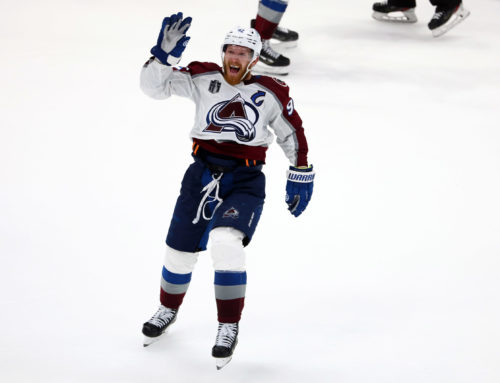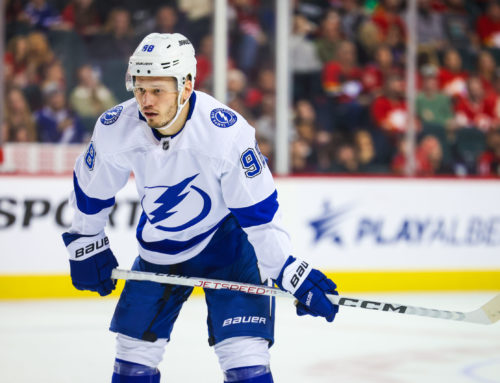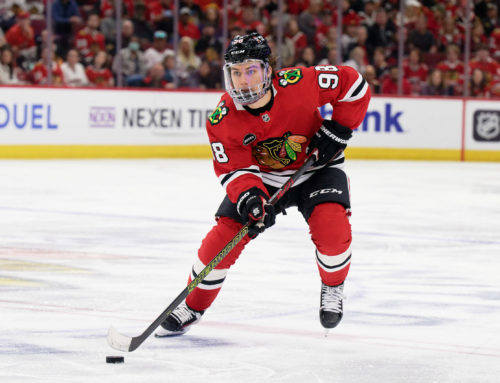It’s all in the Numbers
Ryan Ma
2011-01-11

Last week, Brett Lemon wrote an article regarding Bloom's simple hierarchical system of categorizing cognitive learning and how it related to the process we all need to go through in order to experience success in fantasy hockey. By surfing TSN.ca, the Dobber website, Yahoo! player blurbs or Rotoworld, you're being exposed to the "remembering" level. By consistently following DobberHockey and reading the mid-season guide you're introduced to the "understanding" level. (Still love the "Ma's Laws" by the way)
By making changes to your fantasy squad based on the above information you're "applying". As Lemon previously touched on in his article, "analyzing" and "evaluating" is the toughest part of the gig. This week I'm going to make your life a whole lot easier by introducing tools to help you better analyze and evaluate your team.
First, let’s clear up some general misconceptions about projections:
1) First of all we need to place a realistic value on overall point production.
|
Year |
Number of point-per-game players |
Number of players > than 80 points |
|
2007-08 |
23 |
19 |
|
2008-09 |
20 |
17 |
|
2009-10 |
21 |
17 |
|
2010-11 |
19 |
17 |
- So, just by looking at the table above, realistically there's only 20 or so players that will finish at a point-per-game pace, and probably around 17-18 that will tally more than 80 points. If you break it down to a standard 12-team league, that's roughly one, maybe two, per team. If you're expecting three or four, you either have one hell of a team or you're dreaming.
- What you do need to pay attention to is the group that is a smidge below the mark: Slightly below the point-per-game mark are players like Ryan Kesler, Patrick Kane, Ryan Getzlaf and Nicklas Backstrom who all garner enough responsibility on their respective clubs to get them over the point-per-game hump, but players like Ryane Clowe, Clarke MacArthur, Mikhail Grabovski, Brandon Dubinsky probably won't get there.
2) Ice-time plays a huge factor in point production.
- Of the 17 players that hit the 80-point plateau last season, all of them are essentially top-line and top-PP "household" names. As a group they averaged 20:37 overall and 3:59 with the man advantage per contest.
- So what can you draw from this? Unless players are actually getting "quality" ice-time there's a big chance that they won't get the production that you're after. The tables below will give you a better idea as to what to expect.
3) Team depth is vitally important; a player that's bouncing around between the second and third line isn't going to be a candidate for 70 points, or even 60 according to the numbers below.
|
Player's rank on respective team |
Average # of points tallied |
Median |
Range |
|
Top |
74.3 |
70 |
61 |
|
2nd |
63.7 |
61 |
60 |
|
3rd |
54.8 |
53 |
47 |
|
4th |
46.4 |
47 |
34 |
|
5th |
40.5 |
38.5 |
21 |
|
6th |
35 |
34 |
31 |
- This is the table from last season, looking at average player scoring position for their respective teams. The leading scorer of each team averaged out to tally around 74 points, 63 for second, 54 for third and so on… Of course you have your variants like Henrik Sedin leading the Canucks with 112 points, contrasted to Patrick Hornqvist at 51 for the Preds, but it still paints a general picture.
4) Salary plays a large role in ice-time distribution, and generally speaking if a team is forking out six million or higher in salary for a player, they are going to receive optimal ice-time. In the salary cap era of the NHL, teams will be very hard-pressed to stick a player making bucket-loads of cash on a checking line (unless maybe you're the Leafs).
5) The Western Conference teams are the slightly more offensive of the two conferences.
- The Western Conference teams average 2.80 goals per contest, while their Eastern counterparts average 2.71.
- If you have a comparison between two players in a similar point range, choosing the player in the Western Conference might give you a slight point advantage over the Eastern Conference player.
6) Beware of lofty expectations from rookies.
|
Year |
Number of Rookies > 45 points |
Number of Rookies > 50 points |
Number of Rookies > 60 points |
|
2007-08 |
6 |
4 |
2 |
|
2008-09 |
7 |
2 |
0 |
|
2009-10 |
3 |
2 |
0 |
- It's essentially been three years since we've seen a 60+ point rookie (Patrick Kane and Nicklas Backstrom), so the "new NHL" is trending towards a lowered rookie production than the days of Sidney Crosby and Alex Ovechkin.
- With that said, the high-end rookies could still see 55 points, which isn't all too bad for a debut season. Just don't expect 70+.
7) Be wary of the second-half of the "magical fourth year"
() current point pace.
- Nicklas Backstrom: 69, 88, 101, (74)
- Claude Giroux: 0, 27, 47, (71)
- Brandon Dubinsky: 40, 41, 44, (68)
- Tobias Enstrom: 38, 32, 50, (66)
- Jonathan Toews: 54, 69, 68, (71)
- Patrick Kane: 72, 70, 88, (74)
- Kris Versteeg: 4, 53, 44, (58)
- Bobby Ryan: 10, 57, 64, (53)
- Sam Gagner: 49, 41, 41, (54)
- Derick Brassard: 2, 25, 36, (53)
- Sergei Kostitsyn: 27, 23, 18, (50)
Second half numbers during the "magical fourth year" of recent fourth year breakouts: Mike Richards 1.03, Ryan Getzlaf 1.06, Pavel Datsyuk 1.17, Zach Parise 1.11, Ilya Kovalchuk 1.08, Jeff Carter 0.92, Mike Cammalleri 1.19, Anze Kopitar 1.02, and Paul Stastny 1.02.
Now, onto the real mathematical stuff! Keep in mind these are general average numbers, there may be certain exceptions to each scenario.
* Last season the top 10 numbers were the stats from all of the top 10 skaters in each category. This season I broke it down into two sections (point-per-game and top 10). I basically used the five players that were closest to the top 10 to determine their values, so if there are large discrepancies between the top 10 of this year and last year, that's probably why.
|
Centers |
Games Played |
Goals |
Assists |
SOG |
Ice-time |
PP Ice-time |
|
Point-Per-Game |
41.7 |
20.8 |
32.8 |
142.2 |
21:00 |
4:33 |
|
Top 10* |
39.6 |
13.0 |
25.2 |
89.0 |
19:53 |
3:23 |
|
60-point |
40.2 |
15.0 |
15.0 |
120.7 |
18:44 |
3:12 |
|
50-point |
40.1 |
9.7 |
15.1 |
90.8 |
17:39 |
2:54 |
|
35-point |
35.4 |
7.2 |
8.1 |
70.3 |
17:14 |
1:49 |
* includes Pavel Datsyuk and Ryan Getzlaf, so numbers maybe a bit lower than expected.
|
Last Season |
Games Played |
Goals |
Assists |
SOG |
Ice-time |
|
Top 10 |
44.4 |
17.2 |
32.5 |
123.3 |
20:48 |
|
60-point |
42.1 |
11.1 |
21.9 |
106.6 |
19:51 |
|
50-point |
40.2 |
10.5 |
16.1 |
95.4 |
18:26 |
|
35-point |
40.0 |
7.7 |
12.6 |
81.5 |
17:10 |
|
Left Wing |
Games Played |
Goals |
Assists |
SOG |
Ice-time |
PP Ice-time |
|
Point-Per-Game |
42.2 |
19.2 |
27.8 |
153.6 |
20:03 |
3:53 |
|
Top 10 |
41.2 |
14.4 |
18.0 |
116.4 |
17:24 |
3:14 |
|
60-point |
41.7 |
13.2 |
16.2 |
105.0 |
18:14 |
3:09 |
|
50-point |
40.0 |
11.1 |
12.3 |
96.9 |
17:06 |
2:34 |
|
35-point |
41.0 |
8.3 |
9.3 |
67.2 |
14:41 |
1:42 |
|
Last Season |
Games Played |
Goals |
Assists |
SOG |
Ice-time |
|
Top 10 |
41.5 |
20.2 |
21.9 |
141.9 |
19:54 |
|
60-point |
42.2 |
15.2 |
17.8 |
120.8 |
18:11 |
|
50-point |
39.6 |
12.1 |
14.6 |
96.3 |
17:15 |
|
35-point |
40.5 |
16.1 |
9.5 |
70.0 |
14:23 |
|
Right Wing
📢 advertisement:
|
Games Played |
Goals |
Assists |
SOG |
Ice-time |
PP Ice-time |
|
Point-Per-Game* |
44.0 |
19.5 |
29.5 |
147.5 |
21:22 |
4:03 |
|
Top 10 |
39.1 |
16.0 |
17.8 |
115.6 |
17:53 |
3:10 |
|
60-point |
39.0 |
13.6 |
16.4 |
126.0 |
19:50** |
3:32 |
|
50-point |
36.8 |
9.2 |
15.3 |
92.5 |
17:52 |
2:59 |
|
35-point |
36.4 |
7.4 |
9.6 |
77.7 |
15:35 |
1:41 |
*small sample size only Martin St. Louis and Corey Perry
|
Last Season |
Games Played |
Goals |
Assists |
SOG |
Ice-time |
|
Top 10 |
44.2 |
18.4 |
24.9 |
138.6 |
20:17 |
|
60-point |
41.7 |
11.7 |
18.1 |
108.3 |
18:14 |
|
50-point |
43.7 |
11.4 |
14.7 |
105.1 |
16:00 |
|
35-point |
36.8 |
9.1 |
9.6 |
78.6 |
16:43 |
The RW cohort is a very interesting one, as the numbers don't really fall into line. The "top 10" cohort had guys like Milan Hejduk, Justin Williams, Rick Nash, Dustin Brown and Daniel Briere who are all kind of second line RWers on "good" high scoring teams. The "60-point" cohort had guys like Phil Kessel, Shane Doan and Dustin Penner who were top-line guys but on less offensive teams. As you can see the 19:50 ice-time average is very high compared to the cohort group that averaged just 18:14 at the same time last season. Expect the two groups to actually switch places by season's end.
|
Defenseman |
Games Played |
Goals |
Assists |
SOG |
Ice-time |
PP Ice-time |
|
Top 5 |
43.8 |
9.6 |
27.8 |
109.2 |
23:47 |
4:20 |
|
Top 10 |
38.6 |
3.6 |
25 |
86.6 |
23:08 |
4:19 |
|
40-point |
36 |
4.2 |
15.8 |
60.6 |
22:55 |
3:16 |
|
30-point |
36.2 |
3.2 |
11.8 |
59.3 |
22:45 |
2:47 |
|
25-point |
39.1 |
2.9 |
9.6 |
57.3 |
21:13 |
1:58 |
|
Last Season |
Games Played |
Goals |
Assists |
SOG |
Ice-time |
|
Top 10 |
44.5 |
6.7 |
25.4 |
91.5 |
24:36 |
|
40-point |
43.5 |
5.9 |
16.1 |
75.8 |
22:05 |
|
30-point |
40.1 |
3.3 |
12.7 |
62.8 |
21:18 |
|
25-point |
39.2 |
3.2 |
10.8 |
50.0 |
20:45 |
Goalies
I didn't know how to tier the goalies without getting 50 billion complaints about how I did it, so I guess I'll just state some quick points.
- Only three goalies (Jimmy Howard, Carey Price and Jonas Hiller) are on pace to finish with 40 or more wins compared to five last season.
- Seven more are on pace for 35 wins or more.
- Only two goalies are on pace for 70+ starts.
- Fantasy Impact: more teams are using split-time/tandem situations than a number one/number two option. For example, the once sure fire 70-start goalie Roberto Luongo is only on pace to start 62 contests this season.
- The top 50 fantasy-worthy goalies have averaged 24.2 starts and 12.0 wins.
- Of those 50, only eight have a win percentage of greater than 60 percent with a minimum of 30 games played.
|
Goalies |
Starts |
Win Percentage |
GAA |
Save Percentage |
|
Top 5 |
33.6 |
60.7 |
2.37 |
0.921 |
|
15 win |
28.8 |
51.7 |
2.52 |
0.916 |
|
10 win |
19.5 |
51.3 |
2.89 |
0.902 |
|
5 win |
14.6 |
35.1 |
3.08 |
0.896 |
|
Last Season |
Starts |
Win Percentage |
GAA |
Save Percentage |
|
Top 5 |
N/A |
64.0 |
2.18 |
0.926 |
|
20 win |
36.8 |
54.0 |
2.46 |
0.912 |
|
15 win* |
29.3 |
52.3 |
2.51 |
0.919 |
|
10 win |
21.8 |
45.8 |
2.36 |
0.910 |
* small sample size.
So you're probably sitting there wondering, there's a whole bunch of numbers, what does it all mean? Here are three examples of how I would use the numbers to determine the second-half.
For the first example I'm going to examine someone who I think is overachieving. Loui Eriksson has 46 points in 43 contests, while averaging 20:42 overall and 3:21 on the PP for the Stars. He also has 97 SOG and is currently ranked eighth in overall scoring in the NHL. Eriksson has spent 83.16 percent of his overall shifts alongside Brad Richards (another point-per-game player), which does show that he's an integral part of the Stars offense. His ice-time seems to fall in line with his peers, but it's the SOG that's nearly 20 off the pace. Is he a certified top 10 LWer? His numbers certainly prove so, but is he good enough for point-per-game? I don't think so, so look for a dip in numbers during the second-half to align itself.
Let's try a second example to make sure that we're all on the same page. Alex Kovalev is averaging 16:06 per contest amongst and has recorded just 18 points on the season. His power-play ice-time isn't all too flashy at just 2:09 per game and he's also picked up 98 SOG. The numbers project him to be more of a 45-point scorer by season's end, which makes him borderline ww material. If you are a Kovalev-owner and is expecting a turnaround, it might be a smart play to move on and look for other alternatives.
For a third example we can take a backwards approach. Let's take a look at Sergei Kostitsyn's stats, so far he's played in 37 contests, while averaging 13:25 per contest and has tallied 23 points. If you break it down a bit further, in the last month he has boosted that average to 17:36 and 2:25 on the PP in 14 contests, so really it was the start-of-year stats that are dragging his overall totals down. If you use his current numbers, he's more of a 55-60 point player than a 46-point pace that's he's currently on. So expecting somewhere around 30-35 points in the final 41 contest is fairly reasonable if he maintains this recent trend. At just 13 percent Yahoo!-owned, he's a bargain bin pickup to help provide an offensive boost to your fantasy squad.
So hopefully you can use the guidelines and numbers above to help you gain a better grasp of what to expect for player X moving forward. As the last tier of Bloom's simple hierarchical system of categorizing cognitive learning, you need to go out and "create". Now use this information and create changes to win a fantasy championship. Of course if you are desperately seeking different opinions, hop onto the DobberHockey Forums where there are plenty of fantasy fanatics who are ready and willing to give you their opinions. Questions or comments? Like always I'll be ready and willing to discuss them with you in the comments section below.





 BUF
BUF N.J
N.J PHI
PHI MIN
MIN FLA
FLA WPG
WPG VAN
VAN TOR
TOR CGY
CGY